Seven years ago, we found our perfect place. We skipped condo buying and went straight for a house in the city. It seemed kind of suburban to do that, and yet we were well within the Chicago city limits. We had a yard and a fence. Our house is close to everything: Target. Home Depot. A supermarket that we could walk to. It’s near a park, the highway and public transportation that would get us downtown or to the airport in a breeze.
We knew all that going in. We didn’t know how much we would come to love the gyro joint at the end of the block. Or the incredible selection of beers and ciders at the liquor store next to it.
There were places to eat and drink and enjoy our lives as newlyweds.
Then a funny thing happened. And then two more funny things happened. Now we had a 150 percent increase in the number of people occupying our little three-bedroom/two-bath. We’d meant for this to be our “starter” home all along, and we thought we’d stay for about five years and then see where we landed from there. Now we just had a little more reason to pack up than we’d thought.
The location became more important when our kids were young. We lived right near the highway, which was great for when we drove or carpooled to work. Living just outside of the express lanes cut our commute even further. If we didn’t want to drive, two bus lines ran right at the end of the block that would connect to a subway line. We could also walk to the train if weather and time permitted.
Being near the highway also meant we could easily get out to the suburbs to see family or shop. The suburban Costco was much more minivan friendly. The Chicago Botanic Garden became a needed refuge for our family to find some nature and quiet just outside our city.
As our kids have grown, we need more and different space. The fenced-in backyard let the kids play safely, but backyards can isolate us. Bigger front yards encourage kids to play together with their neighbors.
The park a few blocks away was always a treat no matter how many times we swung on its swings and slid down its slides. The sidewalk outside worked well for tiny wheels and tentative steps. But all around us were busy streets. Supervised walks were great; freedom to roam was out of the question. Walkability can also be defined differently for adults or adults holding the hands of fidgety toddlers.
Our daughter wound up in a great program offered by Chicago Public Schools, but the trade-off was a 20-minute drive each way because it wasn’t in the neighborhood. The way the selective enrollment and lottery systems work, it was almost certain that her siblings wouldn’t get into the same school. In fact, they could easily wind up in three different schools in three different parts of the city. That means that her classmates are also spread around. There’s no playing on the block after school. There’s no walking home together. It’s much harder to form community.
I can’t imagine a better reason to move to the suburbs than that.
The school situation also meant that my commute, which used to be quick and easy on public transportation or even bike, now was taking me close to 90 minutes a day.
All of this is to say that we’re a little less “city” now than we were when we were in our 20s and even our 30s. There’s nothing inherently wrong with our current place. Instead, our changing demographics lead to changing definitions of livability and a need to rethink if this was still the best place for us .
And so, we’re packing up. We’re leaving the big city we love. We’re headed for someplace similar but different. Smaller. It’s still kind of city-like, but with great schools and a real sense of community.
Stay tuned for more on that. But first, I’ve got to tell you how we sold this house.
